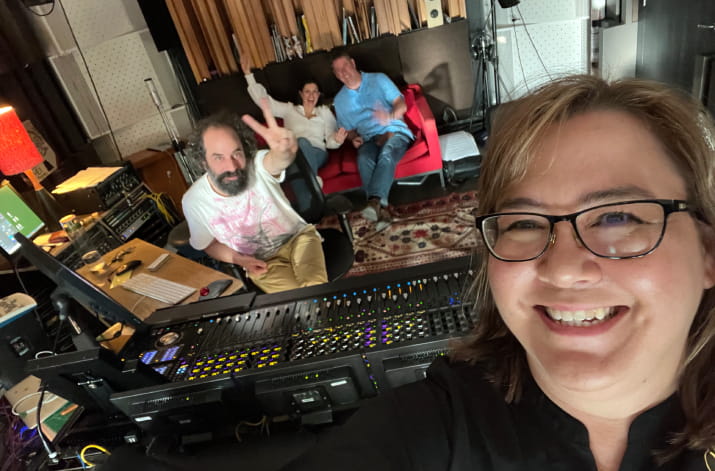
Art history courses
Help me choose a courseIntroduction to Art history
Art has been used as an expression of human emotion for centuries. Artists have long sought to interpret what they see in the world by creating imagery, performance, sculpture and installation pieces. Studying art history helps us make sense of their work and our world more broadly.
Whether you want to study art and fashion, Aboriginal art, contemporary, modern, or classical art, there’s an art history course sure to interest you. Discover the short courses, standalone subjects and full qualifications you can study with leading universities through Open Universities Australia.
Explore art history courses
Discover art history courses
Online art history subjects and short courses
Introduction to the GLAM sector
UndergraduateUSA-HUMS1058
- Study method
- 100% online
- Entry requirements
- No ATAR required. Start with a subject.
- Start dates
- Starts 07 Apr 2025, 22 Sep 2025
Next enrolment closes 30 Mar
Narrating Objects, Art and Archives
UndergraduateUSA-HUMS3052
- Study method
- 100% online
- Entry requirements
- No ATAR required. Start with a subject.
- Start dates
- Starts 07 Apr 2025
Next enrolment closes 30 Mar
UndergraduateCUR-VIS29
- Study method
- 100% online
- Entry requirements
- No ATAR required. Start with a subject.
- Start dates
- Starts 02 Jun 2025, 01 Dec 2025
Collecting Power: Museums, Colonialism, and Restitution
UndergraduateLTU-ART2002
- Study method
- 100% online
- Entry requirements
- No ATAR required. Start with a subject.
- Start dates
- Starts 28 Jul 2025
Online art history degrees
UndergraduateGRF-ART-DEG
Innovators, communicators and creators start here!
- Study method
- 100% online
- Duration
- 3 years full time or part time equivalent
- Entry requirements
- No ATAR required. Start with a subject.
Available majors
- Art History,
- Creative Writing,
- Criminal Justice,
- History,
- Journalism,
- Literature,
- Public Relations,
- Screen and Media Studies,
- Sociology
UndergraduateCSU-ART-DEG
Prepare for life and work with the ultimate skill set
- Study method
- Online & on-campus
- Duration
- 3 years full time or part time equivalent
Undergraduate Certificate in Art History
UndergraduateCUR-ART-CTF
Glimpses of the history of art and design
- Study method
- 100% online
- Duration
- 6 months full time or part time equivalent
- Entry requirements
- No ATAR required. Start with a subject.
UndergraduateLAT-ART-DIP
Start with the subjects you’re passionate about
- Study method
- 100% online
- Duration
- 1 year full time or part time equivalent
- Entry requirements
- No ATAR required. Start with a subject.
Available majors
- Arts stream,
- Criminology stream,
- Global studies stream,
- Politics, philosophy and economics stream,
- Visual arts stream
Need help choosing the right course?
Our student advisors are here to guide you with expert advice on:
- Enrolling and planning your studies
- Finding a study option that suits your needs
- Understanding your funding options



When would you like to chat?
Let me pick a time
Find a time that suits you for a free 1:1 consultation with a student advisor.
Call me anytime
A student advisor will call you, usually within 30 minutes during business hours.
Looking for other ways to start the conversation? Contact us
Student reviews
We support thousands of students on their study journey every year
Our advisors are here to help with your study goals from enrolment to completion 7 days a week.
Art history study FAQs
What is art history?
Art is everywhere. From cave paintings to the works of Rembrandt, Picasso, Monet and Renoir to contemporary pieces by artists like Tracey Emin, art offers a window into a time, place, and social context. Art history specifically examines art of the past, how it shapes contemporary art, and what it tells us about past societies.
Much can be learned about history by examining the art that emerged from that period, a skill you’ll hone in your art history studies.
What do you learn in an art history course?
Art history courses cover a wide range of topics. As an art history student, you’ll learn to appreciate art's historical, social and cultural contexts.
As a graduate of one of the many art history courses available through Open Universities Australia, you’ll learn to critique art, reflect on art, and understand and communicate the context of particular art pieces. Many art history courses include elements of art curation and collection management, a fascinating field in itself.
What you learn in the specific course you choose will depend on whether art history is the focus of your course, your major, or a small component of it. What kind of course best fits your circumstances depends on your motivations and future plans. If you’re not sure what course is best for you, get in touch with our team. We’re here to answer your questions about courses, enrolment, fees, and deadlines.
You’ll also improve essential soft skills like teamwork, critical analysis, clear communication, and work ethic.
How long is an art history course?
It depends on the course and whether you choose something short or long-term. Here’s a general guide:
| Course | Duration |
|---|---|
| Single subject | 10-18 weeks |
| Short course | 10-18 weeks |
| Undergraduate certificate | 6 months (if full time) |
| Diploma | 1 year (if full time) |
| Associate degree | 2 years (if full time) |
| Bachelor degree | 3 years (if full time) |
| Graduate certificate | 6 months (if full time) |
| Graduate diploma | 1 year (if full time) |
| Masters degree | 2 years (if full time) |
If you study a degree in art history through Open Universities Australia, you have the flexibility to choose how many subjects you take per term. This means you can complete your qualification at a faster or slower pace than you would on campus.
Why should I study art history?
If you love art, you might be wondering how you can begin a career in the arts. An online art history course is a great place to start. Art history is a fascinating field, bringing together elements of sociology and history with an appreciation for artistic practice throughout the centuries.
If you want to take a peek into the world of art history without committing to an entire course, consider single subject study. Single subject study allows you to get a feel for a study area or upskill to further your interests or career.
Why should I study art history online?
There are many lifestyle advantages to studying online. You can manage your study load flexibly and watch lectures and tutorials from the comfort of home.
This makes it easier to fit in your other commitments, whether they be work, family, or anything else.
Why should I study online through Open Universities Australia?
There are a lot of reasons to study your course online through us.
- You can enrol without entry requirements
We have a unique open-door policy that makes it possible for everyone to enrol in university study, no matter their academic history. If you don’t meet the entry requirements for a degree, we’ll help you get in through single undergraduate subjects and transition into a qualification from there. - You have total control over how you study
Upskill without committing to a whole degree upfront. Or enrol in a full degree, but take it a subject at a time. We’ll introduce you to flexible study options you didn’t even know about, so you can fit uni around what matters to you. - You’ll graduate with the same qualification as an on-campus student
Once you enrol through us, you’ll study online with the university that provides your degree. This means that when you complete your qualification, you’ll graduate with the same degree as on-campus students. - We’ll help you navigate the university world
Our friendly student advisors will be your guide every step of the enrolment journey. They'll help you compare universities, choose a course, provide documentation and understand your finance options.
What jobs can you get with an art history degree?
While at first glance art history may seem like a very niche study area, it opens graduates up to a wide range of career opportunities. As an art history graduate you could explore the world of arts journalism and writing, bringing the world of the arts to the public, or you might prefer to move into education, where you could inspire a whole new generation to care for and appreciate the arts.
Graduates of art history work across many interesting and diverse fields, including:
- Art history
- Art practice
- Curation
- Arts administration
- Art therapy
- Arts journalism and writing
- Cultural policy development
- Event management
- Education (with further study in the field)
- Museum and gallery collection management
How do I know which art history course is right for me?
Whether you’re interested in art history as a career or want to study for personal interest and enjoyment, there’s an online art history course available through Open Universities Australia for you.
Book a one-on-one phone consultation with our friendly team of student advisors to discuss how you can find the art history course that suits your circumstances best.
How do I know if I’m eligible to apply for a course?
Before starting an enrolment, it’s important to read the entry requirements for your chosen course to ensure that you’re eligible to apply. If you don’t quite meet the requirements, we may be able to help you find a pathway into your course through open-entry subjects, which anyone can study.
Chat with us to find out more.
How do I enrol?
Here at Open Universities Australia, we make enrolling online as straightforward as possible. To get started, find the course for you by browsing the options on this page. You can also compare different qualifications using our handy comparison tool, or request help from one of our student advisors.
When you’ve made your choice, click ‘Apply now’ on the relevant course page and follow the prompts to begin your enrolment. We’ll ask you to supply some supporting documentation, including proof of your identity, your tax file number, and a unique student identifier (USI) during this process.
Your university will get in touch with you via email to confirm whether or not your application has been successful.
Please note that enquiries and applications for some courses are handled directly by the university. If this is the case, it will be indicated on the course listing page.
For more information about enrolment, read our online self-service enrolling instructions. If you get stuck at any time, contact us and we’ll talk you through it.
Student stories and study advice

11 fun and engaging short courses for seniors
Retired and ready to challenge yourself? Or just eager to learn a new skill? Here are our favourite short online courses for seniors in 2025. They cover everything from computer skills to genealogy, and only run for 8 to 14 weeks.
7 of the best graphic design short courses to study online
Want to wow people with your logo art, magazine layouts or website designs? These short online courses cover everything a graphic designer needs to know, from Adobe Creative Cloud to user-centred design.
Why you should study art online
Studying art online might sound hard to imagine. But there can be many benefits to exploring your creativity through a virtual university short course or degree.
An Aussie composer on how to get into the music industry
Is it hard to make it in the local music industry? Jessica Wells, a successful composer, orchestrator and arranger reveals the challenges and opportunities that you might face on your journey to stardom.We’re here to guide you to the right uni course

Open Universities Australia is a not-for-profit organisation helping every Australian to access thousands of university courses.
Over 527,000 students have enrolled in university through us since 1993.
How we can help you
Studying through Open Universities Australia means we take care of the guesswork and administration of university study, so you can focus on learning.
You don't need a strong academic history to go to uni
We make it possible for everyone to start university through single subjects, regardless of ATAR or study experience. These subjects are covered by government loans, and can be used to upskill or gain entry into a qualification.
You have the flexibility to start at multiple points during the year
We’re not restricted by a traditional academic calendar, so you can enrol when it suits your life. You also have total control over how you study. You can scale up (or down) your study load and even pause your course if you need to.
You can rely on us as an unbiased destination for online tertiary education
As a not for profit, we have your best interests at heart. Our advisors are here 7 days a week to guide and support you. It’s our priority to get you qualified with the university of your choice.

























